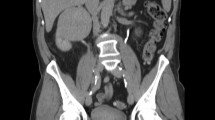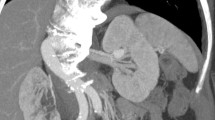Abstract
Purpose
This study reviews our experience over the last 10 years with procedures of embolisation and/or exclusion of the renal arteries, their parenchymal branches and the polar arteries [renal artery embolisation (RAE)].
Materials and methods
Twenty-seven patients (19 men and eight women; age range 37–93 years; mean 74 years) underwent RAE. The indications were: symptomatic gross haematuria in nine patients (33.3%) (tumour-related in seven and iatrogenic in two), symptomatic inoperable renal tumour in five (18.5%), large subcapsular or perirenal haematoma in three (11.1%) and aneurysm of the main renal artery in two (7.4%). Eight patients (29.6%) scheduled for endovascular aneurysm repair (EVAR) of the abdominal aorta underwent prophylactic embolisation of the renal polar branch arising from the aneurysmal sac or the subrenal aortic neck to prevent the possible revascularisation of the sac. Different embolisation agents were used: coils (17 cases), embolisation particles (14 cases), glue (one case), coated stent (two cases) and mechanical occlusion devices (two cases). In 11 cases, two to three different embolisation agents were used together.
Results
Technical success was achieved in 26/27 patients (96.3%); in one case, embolisation of a polar artery arising from the aneurysmal sac was not possible. One case of gross haematuria recurred 13 months after the procedure and was re-treated with success. There were no cases of major or minor complications.
Conclusions
RAE is an effective and minimally invasive procedure in the treatment of neoplastic/iatrogenic symptomatic gross haematuria and in the palliative treatment of inoperable renal tumours. One possible new indication is the prophylactic exclusion of the polar artery arising from the neck or the sac of an abdominal aortic aneurysm in patients who are candidates for EVAR. In our experience, we observed very low morbidity and a short hospital stay. This procedure requires the availability of various materials for performing embolisation and experience in their use.
Riassunto
Obiettivo
Scopo di questo lavoro è rivalutare la nostra esperienza degli ultimi 10 anni nelle procedure di embolizzazione o esclusione delle arterie renali (EAR), dei suoi rami parenchimali e delle arterie polari.
Materiali e metodi
Ventisette pazienti (19 maschi e 8 femmine; età 37–93 anni, media 74 anni) sono stati sottoposti a procedura di EAR. Le indicazioni sono state: macroematuria sintomatica in 9 pazienti (33,3%) (tumorale in 7 casi e iatrogena in 2), tumore renale sintomatico inoperabile in 5 pazienti (18,5%), voluminoso ematoma sottocapsulare o perirenale in 3 casi (11,1%) ed aneurisma dell’arteria renale principale in 2 casi (7,4%). In 8 pazienti (29,6%) candidati a posizionamento di endoprotesi aortica addominale (EVAR) si è proceduto alla preventiva embolizzazione del ramo renale polare originantesi dalla sacca aneurismatica o dal colletto sottorenale aortico per prevenire la possibile rivascolarizzazione della sacca. Sono stati utilizzati diversi agenti embolizzanti: spirali (17 casi), particelle embolizzanti (14 casi), colla (1 caso), stent ricoperto (2 casi), occlusore meccanico (2 casi). In 11 casi sono stati utilizzati insieme 2–3 diversi agenti embolizzanti.
Risultati
Il successo tecnico è stato ottenuto in 26/27 pazienti (96,3%); in un caso non è stato possibile embolizzare un’arteria polare originante dalla sacca aneurismatica. Un caso di macroematuria ha recidivato a distanza di 13 mesi ed è stato ritrattato con successo. Non si sono verificate complicanze maggiori o minori.
Conclusioni
L’EAR è una terapia efficace e minimamente invasiva nel trattamento della macroematuria sintomatica neoplastica/iatrogena e nella palliazione di tumori renali inoperabili. Una possibile nuova indicazione è l’esclusione preventiva dell’arteria polare originantesi dal colletto o dalla sacca di un aneurisma dell’aorta addominale in pazienti candidati ad EVAR. Nella nostra esperienza abbiamo osservato scarsa morbilità e breve degenza intraospedaliera. Questa procedura richiede la disponibilità di diversi materiali per effettuare l’embolizzazione ed esperienza nel loro utilizzo.
Similar content being viewed by others
References/Bibliografia
Schwartz MJ, Smith EB, Trost DW (2006) Renal artery embolization: clinical indications and experience from over 100 cases. BJU Int 99:881–886
Maxwell NJ, Saleem Amer N, Rogers E et al (2007) Renal artery embolization in the palliative treatment of renal carcinoma. Br J Radiol 80:96–102
Guy L, Alfidja T, Chabrot P et al (2007) Palliative transarterial embolization of renal tumors in 20 patients. Int Urol Nephrol 39:47–50
Somani BK, Nabi G, Thorpe P et al (2006) Therapeutic transarterial embolisation in the management of benign and malignant renal conditions. Surgeon 4:348–352
Subramanian VS, Stephenson AJ, Goldfarb DA et al (2009) Utility of preoperative renal artery embolization for management of renal tumors with inferior vena cava thrombi. Urology 74:154–159
Vaicekavičius E, Pranculis A (2002) Transcatheter embolization of renal neoplasms: clinical results and indications for usage in multiprofile hospitals. MEDICINA 38:888–891
May M, Brookman-Amissah S, Pflanz S et al (2009) Pre-operative renal arterial embolisation does not provide survival benefit in patients with radical nephrectomy for renal cell carcinoma. Br J Radiol 82:724–731
Breyer BN, McAninch JW, Elliot SP et al (2008) Minimally invasive endovascular techniques to treat acute renal hemorrhage. J Urol 179:2248–2253
Fisher RG, Ben-Menachem Y, Whigham C (1989) Stab wounds of the renal artery branches: angiographic diagnosis and treatment by embolization. AJR Am J Roentgenol 152:1231–1235
Mavili E, Dönmez H, Ozcan N et al (2009) Transarterial embolization for renal arterial bleeding. Diagn Interv Radiol 15:143–147
Cohenpour M, Strauss S, Gottlieb P et al (2007) Pseudoaneurysm of the renal artery following partial nephrectomy: imaging findings and coil embolization. Clin Radiol 62:1104–1109
Pappas P, Leonardou P, Papadoukakis S et al (2006) Urgent superselective segmental renal artery embolization in the treatment of life-threatening renal hemorrhage. Urol Int 77:34–41
Mavili E, Dönmez H, Dursun I et al (2008) Embolization of postbiopsy and postnephrostomy complications in transplanted kidney: a case report. Transplant Proc 40:3767–3769
Uberoi J, Badwan KH, Wang DS (2007) Renal artery pseudoaneurysm after laparoscopic partial nefrectomy. J Endourol 2:330–333
Jain V, Ganpule A, Vyas J et al (2009) Management of non-neoplastic renal hemorrhage by transarterial embolization. Urology 74:522–526
Mukund A, Gamanagatti S (2010) Ethanol ablation of renal cell carcinoma for palliation of symptoms in advanced disease. J Palliat Med 13:117–120
Serafin Z, Karolkiewicz M, Strześniewski P et al (2007) Palliative percutaneous kidney embolization with enbucrilate in patients with renal cell carcinoma: safety and symptom control. Med Sci Monit 13(Suppl 1):98–104
Giuliani L, Carmignani G, Belgrano E, Puppo P (1979) Transcatheter arterial embolization in urological tumors: the use of isobutyl-2-cyanoacrylate. J Urol May 121:630–634
Papo J, Baratz M, Merimsky E (1981) Infarction of renal tumors using isobutyl-2 cyanoacrylate and lipiodol. AJR Am J Roentgenol 137:781–785
Leonardi M, Barbara C, Simonetti L et al (2002) Glubran 2: a new acrylic glue for neuroradiological endovascular use experimental study on animals. Interventional Neuroradiology 8:245–250
Altit R, Brown DB, Gardiner GA (2009) Renal artery aneurysm and arteriovenous fistula associated with fibromuscolar dysplasia: successful treatment with detachable coils. J Vasc Interv Radiol 20:1083–1086
Cambpell JE, Davis C, Defade BP et al (2009) Use of Amplatzer vascular plug for trancatheter embolization of a renal arteriovenous fistula. Vascular 17:40–43
Pride YB, Nguyen MC, Garcia LA (2008) Management of a renal artery aneurysm with coil embolization. J Invasive Cardiol 20:470–472
Serter S, Oran I, Parildar M et al (2007) Fibromuscular dysplasia-related renal artery stenosis associated with aneurysm: successive endovascular therapy. Cardiovasc Intervent Radiol 30:297–299
Klein GE, Szolar DH, Breini E et al (1997) Endovascular treatment of renal artery aneurysms with conventional non-detachable microcoils and Guglielmi detachable coils. Br J Urol 79:852–860
Liguori G, Trombetta C, Pozzi-Mucelli F et al (2002) Percutaneous Management of Renal Artery Aneurysm With a Stent-Graft. J Urol 167:2518–2519
Ginat DT, Saad WE, Turba UC (2009) Transcatheter renal artery embolization: clinical applications and techniques. Tech Vasc Interv Radiol 12:224–239
Fujii Y, Shimada H, Endo I et al (2007) Management of massive arterial hemorrhage after pancreatobiliary surgery: does embolotherapy contribute to successful outcome? J Gastrointest Surg 11:432–438
Harvey J, Dardik H, Impeduglia T et al (2006) Endovascular management of hepatic artery pseudoaneurysm hemorrhage complicating pancreaticoduodenectomy. J Vasc Surg 43:613–617
Manninen HI, Berg M, Vanninen RL (2008) Stent-assisted coil embolization of wide-necked renal artery bifurcation aneurysms. J Vasc Interv Radiol 19:487–492
Clark TW, Sankin A, Becske T et al (2007) Stent-assisted Gugliemi detachable coil repair of wide-necked renal artery aneurysm using 3-D angiography. Vasc Endovascular Surg 41:528–532
Henry M, Polydorou A, Frid N et al (2008) Treatment of renal artery aneurysm with the multilayer stent. J Endovasc Ther 15:231–236
Bremmer MS, Jacobs SC (2008) Renal artery embolization for the symptomatic treatment of adult polycystic kidney disease. Nat Clin Pract Nephrol 4:236–237
Bonvini R, Alerci M, Antonucci F et al (2003) Preoperative embolization of collateral side branches: a valid means to reduce type II endoleaks after endovascular AAA repair. J Endovasc Ther 10:227–232
Maldonado TS, Gagne PJ (2003) Controversies in the management of type II “branch” endoleaks following endovascular abdominal aortic aneurysm repair. Vasc Endovascular Surg 37:1–12
Lalka S, Johnson M, Namyslowski J et al (2006) Renal interventions after abdominal aortic aneurysm repair using an aortic endograft with suprarenal fixation. Am J Surg 192:577–582
Fan CM, Rafferty EA, Geller SC et al (2001) Endovascular stent-graft in abdominal aortic aneurysms: the relationship between patent vessels that arise from the aneurysmal sac and early endoleak. Radiology 218:176–182
Karmacharya J, Parmer SS, Antezana JN et al (2006) Outcomes of accessory renal artery occlusion during endovascular aneurysm repair. J Vasc Surg 43:8–13
Kaplan DB, Kwon CC, Marin ML et al (1999) Endovascular repair of abdominal aortic aneurysms in patients with congenital renal vascular anomalies. J Vasc Surg 30:407–415
Author information
Authors and Affiliations
Corresponding author
Rights and permissions
About this article
Cite this article
Pozzi-Mucelli, F., Medeot, A., Cernic, S. et al. Multimodal approach to the endovascular treatment of embolisation or exclusion of the renal arteries and their distal and/or polar branches: personal experience. Radiol med 116, 945–959 (2011). https://doi.org/10.1007/s11547-011-0684-7
Received:
Accepted:
Published:
Issue Date:
DOI: https://doi.org/10.1007/s11547-011-0684-7




